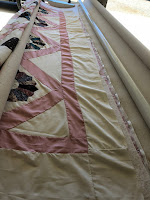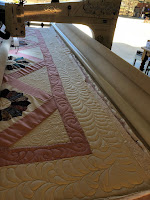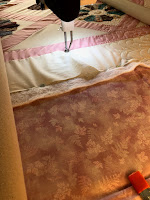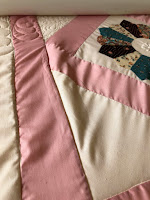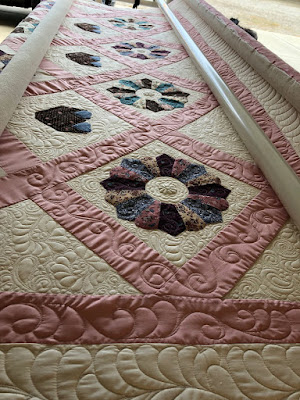A long armer is the last step in the process to finishing your gorgeous quilt. We want more than anything to make you happy with the final result, and as quilters ourselves, we know how much time and effort, money and classes, heart and love has gone into your quilt top. Long armers have a lot invested too, in equipment, (the long arm machine itself is usually in excess of $15,000. and up before the computer) supplies like threads, books, rulers, samples, batting and templates, and a lifetime of learning the skill and creativity it takes to work with the quilt maker to fulfill your dreams for each quilt. It's difficult to charge a fair wage for work that many quilt makers don't understand. A large quilt frame is used, and therefore extra fabric is needed to attach your layers to the rollers. And it's not a long armer's job to fix basic problems when quilts arrive unprepared. Your long arm quilter wants to receive your top and layers and get quilting to make the very best finished quilt possible.
I recently quilted a beautiful, huge bedspread size quilt. I am not judging the quilt maker in any way, in fact, am so proud of her for returning to this project again and again until it was finished. I don't think she has any other quilting experience, so she didn't know a lot of the things we learn in class. But there were a few issues with borders and sashing that had not been measured carefully, and the quilt had been constructed on and off over 25 years, by hand and by machine...there was over an inch extra border fabric at every corner that I had to work in with the quilting to make the quilt lay flat! The sashing puckered and had to be careful quilted so as not to have pleats, and not one seam on the whole quilt was straight, due partially to using French (enclosed) seams during construction...so at some times I was quilting through up to seven layers. It was so much extra time and care, and frustration. Many broken needles and shredded threads. (I, like most long armers charge by the square inch, and lose money when extra work has to be done in just prep and problem solving) I had to adjust my quilt designs to take up lots of extra fabric, and had to increase the density in the pieced appliqué blocks to keep things flat and straight working down the quilt from top to bottom on the frame. In addition, because of having been stored on and off, there were several spots on the quilt with water marks from being wet, or bleeding from prints onto lighter background fabric. I took pictures as I went and tried my best to use designs to hide places where discoloration might show. I decided from the beginning not to mark the quilt since the fabric was old enough to be unreliable. On the up side, I learned to solve problems I had never seen before, and came out a better quilter! But I think I ended up making about $2.00 an hour with a $24,000.00 long arm machine. Not ideal to support my studio.
~1~ STRAIGHT/PLUMB/TRUE
When spending all that time and money piecing your beautiful quilt, it is so important to measure accurately, cut correctly and sew exacting 1/4 inch seams to insure your quilt is straight and true. For a long armer, stitching in the ditch and around appliqué, and designing and quilting lovely sashing and borders depend on straight seams, and accurate piecing. A long armer can cover some small indiscretions, and can straighten and adjust to a point, but the end product and finished beauty of your quilt starts with you!
~2~ PRESSING TO PREPARE
There are different styles and preferences of which way to press: open seams, to one side or the other, and to the dark side (darker fabric color/print). But which ever you choose, when your top is complete, press and steam your beautiful work thoughtfully and thoroughly. When the long armer loads your top onto the frame, the best success can be achieved with crisp, smooth and flat seams! Stitching in the ditch makes your finished quilt look so beautiful, and with a good pressing to one side, the SID threads are almost invisible as they sink into the seam in the groove left by the layers beneath pressed to one side or the other. It makes the long armer's job easier, but more importantly, looks amazing when it's done! Designs pop, or blend, or flow.
*one school of thought is that pressing to one side or the other is actually prolonging the life of the thread/quilt. By burying the seam threads of the piecing in the double layers of the seam pressed to one side, you are protecting those threads for longer wear, more washing, and more loving use. By pressing open, it is believed, you expose those threads to more wear and stress, reducing the life of the threads and the seam.*
~3~ FREE OF PET HAIR, LINT, AND THREADS
Especially with darker fabrics, when a quilt is made in a home with pets, there are the tell tale signs of their love and attention (hair, lol) left on the quilt top. If possible, use a lint roller or tape to remove as much as possible before you send to the long armer. In my case, I have a lint roller next to my machine, and I do the pick up of threads and pet hair as I go, but it does take extra time away from what I want to be doing...quilting your lovely quilting!
Also, when piecing, watch for those threads that get caught between seams and end up poking through on your quilt top. Or clip them yourself after or during pressing, to insure the top is ready to start. I am always nervous when a top arrives with lots of extra thread, frayed fabric threads, or unclipped construction threads because I don't want one more possibility of damaging your lovely quilt top when I have to cut them on the frame. And of course, all that clean up takes time.
~4~ ADEQUATE BACKING AND BATTING
Backings should be at least four inches longer on all four sides than your quilt top. If seamed, they should also be straight and true, and pressed. If the backing has piecing designs, it should be clear in which direction the piecing should go, and if labels are included in the piecing, the orientation should be made clear to the long armer.
Batting should not be pieced in most cases, and should also be at least 3 inches or so larger on all sides than the quilt top. If possible, it should already be cut to fit, and not left to the long armer to sort out larger sides or pieces if it comes bagged and not as yardage. The least left to chance or communication error, the more success the end product will achieve.
If you need the long armer to do extra services for you, (like piecing your backing, providing batting, or squaring up your quilt for binding, or actually binding the quilt...some long armers do not do these extras, but many do for an added charge), please arrange for them in advance, and make sure the long armer knows what to expect. It impacts the wait time for other quilts in the cue, and will keep everyone clear and respectful of time, cost and outcome.
Do as much prep work as possible in advance, and the result will be more time for the long armer to work on the quilt designs for your glorious quilt!!!
